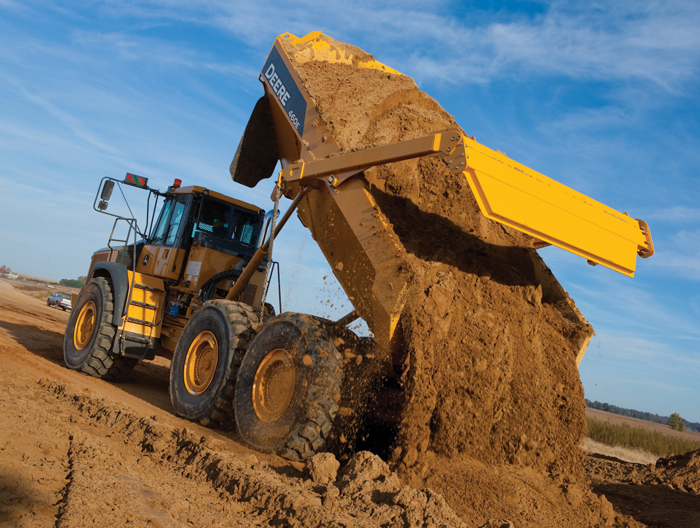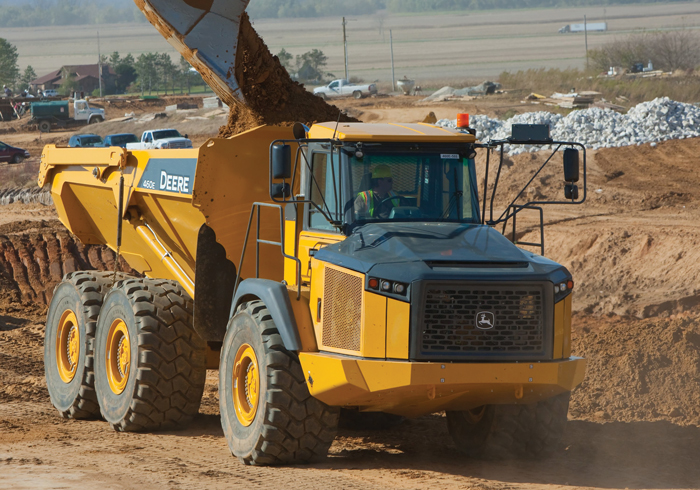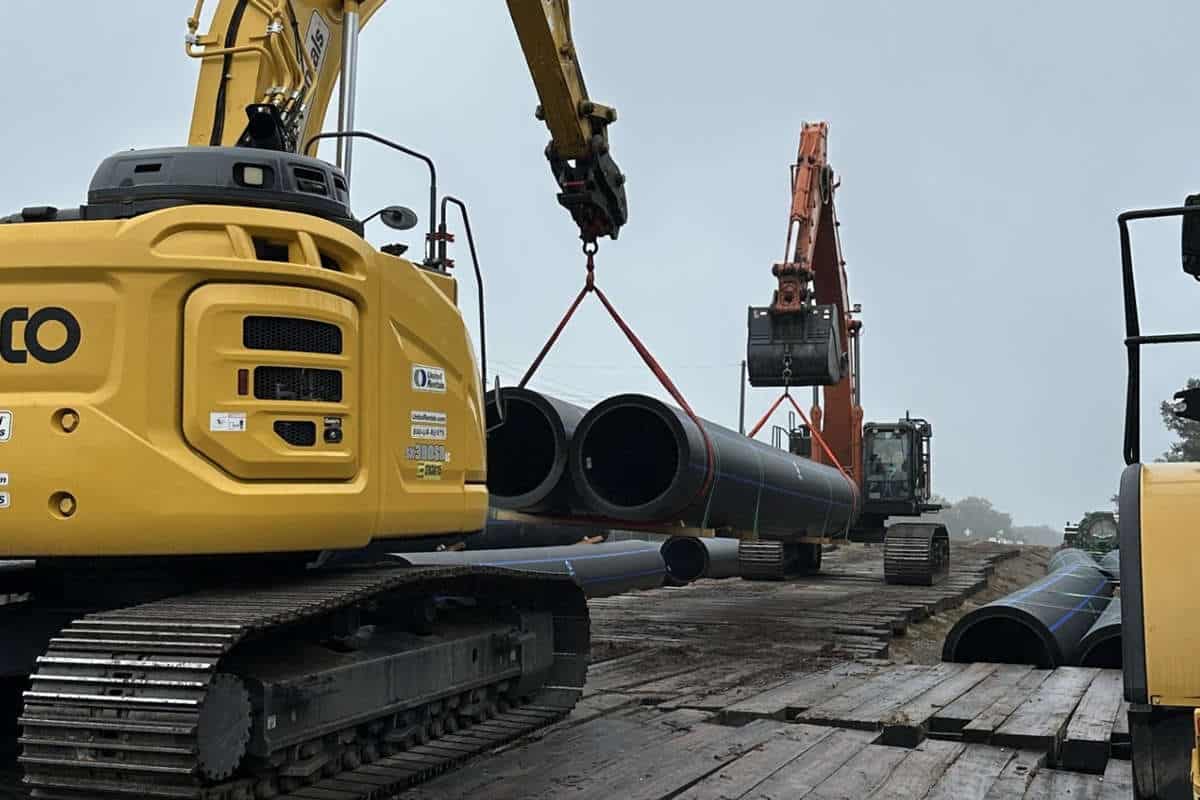Mighty Movers
 Articulated dump trucks, or ADTs as they are often referred to, can play an important role on today’s jobsite. Their versatility and productivity are second to none. If you’re looking to move material — a lot of material — then an ADT may be right for you.
Articulated dump trucks, or ADTs as they are often referred to, can play an important role on today’s jobsite. Their versatility and productivity are second to none. If you’re looking to move material — a lot of material — then an ADT may be right for you.
When examining the different hauler options on the market, contractors must do their research. Is a rigid frame truck ideal or is an ADT the logical choice? Rigid frame trucks are designed to haul large loads of material on well-maintained haul roads, while articulated dump trucks can move the same material, but are designed to run in poorly maintained and harsh areas. ADTs also allow contractors to haul more material at lower cost per ton than other material hauling machine forms.
There are four factors to consider when deciding which truck is right for your business and intended applications: terrain, grade, volume and distance. Terrain is the condition of the haul road and jobsite as a whole. What is the grade of the jobsite? Are there long and/or steep inclines or declines? How much material volume are you looking to transport? Most manufacturers’ largest ADTs fall into the 40-ton class. Distance between the loading tool and dump location is a key consideration as well because you want to keep trucks and equipment moving on the jobsite — a direct correlation to cycle times.
For optimal efficiency, contractors must match ADT capacity with the capacity of the loading tool. Most contractors use an excavator to load ADTs. It is vital for the efficiency of the excavator and maximum productivity of the ADT to have the excavator make full passes while loading the truck. If it takes one extra excavator cycle with only a half bucket to top off the ADT, it is not efficient for the excavator. If the excavator does not load that last half-bucket, the contractor is not optimizing productivity for the ADT. Contractors should look for an ADT size that allows the loading tool to make the optimal amount of passes to fill the ADT for maximum productivity.
ADTs are diverse in that they can haul a variety of materials, including sand, shot rock, dirt, overburden, landfill waste, etc. To navigate haul roads with payload in tow, ADTs must be maneuverable. The oscillation joint in the center of the truck allows the rear half of the chassis to turn side-to-side. This is an advantage when navigating over ruts, rocks, stumps, mud and other unforgiving terrain. The ability to articulate allows the truck to move left or right and maintain a tight turning radius.
ADTs feature a six-wheel drive configuration ideal for heavy-duty applications. Premium trucks also have the ability to lock all three axles together (front to back) known as inter-axle lock as well as manual or automatic differential lock (left to right). Inter-axle lock and differential lock are critical to maneuvering through difficult terrain while optimizing productivity. A full active suspension system assists in carrying massive loads by providing a smooth ride and contributing to less material spillage when going from point A to point B.
When purchasing an ADT, contractors can choose from two tire options — the standard deep tread tires or low-profile tires. Standard deep tread tires provide maximum traction in a variety of applications. Low-profile tires offer lower ground pressure, high flotation and additional stability in wet or sloppy conditions.
 With the varying condition of haul roads and terrain in general, premium ADTs are equipped with a transmission retarder that helps slow the momentum of the truck without using service brakes, thus increasing service brake life. Manufacturers like John Deere have also incorporated intelligent features like descent control that can hold the speed of the truck on a long and steep descent by automatically metering the transmission retarder and reducing operator fatigue. Another important element to consider is the approach angle of the belly-side pan where the engine is housed. When approaching a steep grade, a steeper angle ensures the nose of the truck does not scrape the ground and damage the machine.
With the varying condition of haul roads and terrain in general, premium ADTs are equipped with a transmission retarder that helps slow the momentum of the truck without using service brakes, thus increasing service brake life. Manufacturers like John Deere have also incorporated intelligent features like descent control that can hold the speed of the truck on a long and steep descent by automatically metering the transmission retarder and reducing operator fatigue. Another important element to consider is the approach angle of the belly-side pan where the engine is housed. When approaching a steep grade, a steeper angle ensures the nose of the truck does not scrape the ground and damage the machine.
Other Features to Consider
Safety is a priority on all jobsites and so is equipment maintenance. Look for an ADT that allows an operator to inspect all daily service items from the ground. This will not only save time, but limit the operator from climbing all over the truck to check various service points.
Other features like rollover protection and hill hold contribute to jobsite safety too. Dump-body rollover protection enables an operator to preset an allowable side-to-side rear chassis unloading angle. If the limit is exceeded, the dump body will not raise and a message appears on the monitor instructing the operator to reposition the truck.
A hill hold feature helps prevent machine rollback. When the truck is stopped on a slope, the service brakes remain applied for a short period while the operator’s foot moves from the brake to the accelerator. Some ADTs are equipped with back-up cameras, so you know what’s going on behind you.
High-quality, maintenance-free joints are also a must. The average ADT has somewhere between 30-36 grease fittings, but some manufacturers offer even less that require greasing every 50 hours. The less joints, the less time mechanics or contractors are spending time greasing, and the more time the ADT is hauling and making money.
ADTs are a direct beneficiary of the jobsite technology evolution. More and more manufacturers are integrating telematics into their equipment to give remote access to fleet location, fleet utilization and diagnostic data, monitor machine health and reduce downtime by reading trouble diagnostic codes remotely.
A payload weighing system provides onboard measurement of individual and cumulative loads to reduce tire wear and make sure the truck doesn’t overload. This system can also utilize the information off-board to enable production tracking and business optimization.
These workhorse machines have other added features that will help keep contractors productive, including bin heat and tire pressure monitoring. Ideal for colder climates, bin heat ensures the frozen payload won’t stick to the sides of the dump body. An integrated tire-pressure/temperature-monitoring system helps maximize tire and fuel efficiency. If pressure drops by a specified amount, a passive alarm appears on the monitor. Low tire pressure generates increased tire temperature, which in turn creates premature tire wear.
The benefits of articulated dump trucks are endless. They’re machines that are easily operable and can help any material moving business make more money. Take the time to research the truck that is right for you and be sure to speak with your local dealer before making the big purchase.
David Wilson is a John Deere Product Marketing Manager, based in Moline, Ill.




